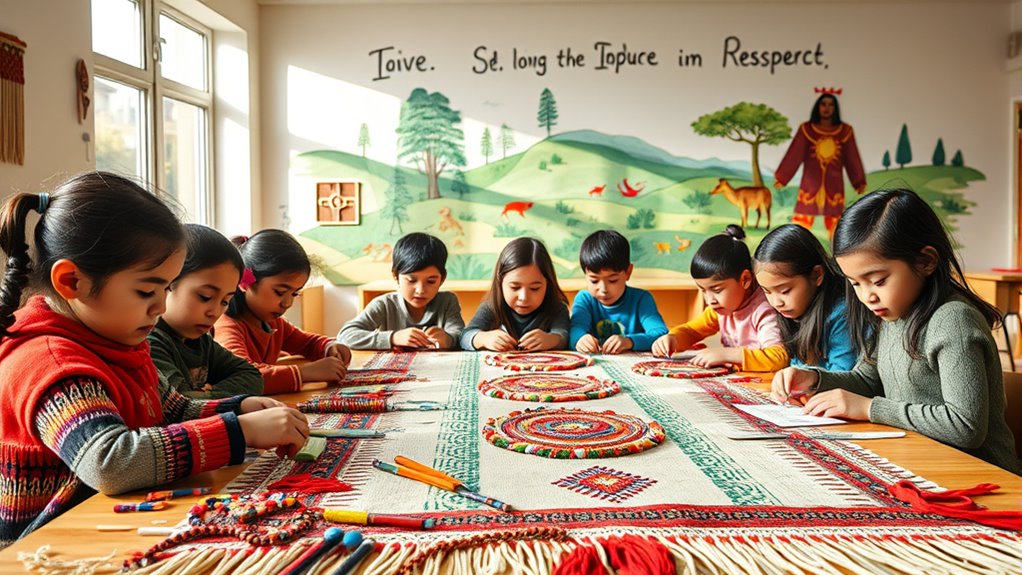To create a Columbus Day lesson plan that emphasizes respect for Indigenous crafts, you should combine historical awareness with cultural sensitivity. Start by explaining the complex legacy of Columbus Day and its impact on Native communities. Prepare authentic materials and incorporate indigenous symbols thoughtfully. Foster open dialogue, ensuring respectful communication. Engage students in hands-on craft activities that highlight indigenous traditions, then encourage reflection. Continuing your approach will help you plan meaningful lessons that honor Indigenous cultures and promote understanding.
Key Takeaways
- Incorporate indigenous perspectives and histories to promote respectful understanding of cultural significance in crafts.
- Use authentic materials and motifs to honor indigenous traditions and avoid cultural misappropriation.
- Prepare clear, culturally sensitive instructions emphasizing the importance of respect and representation.
- Facilitate open dialogue and active listening to foster empathy and inclusive discussions about indigenous crafts.
- Include reflections on colonization’s impact and resilience of native communities to deepen awareness and respect.
Understanding the Historical Context of Columbus Day
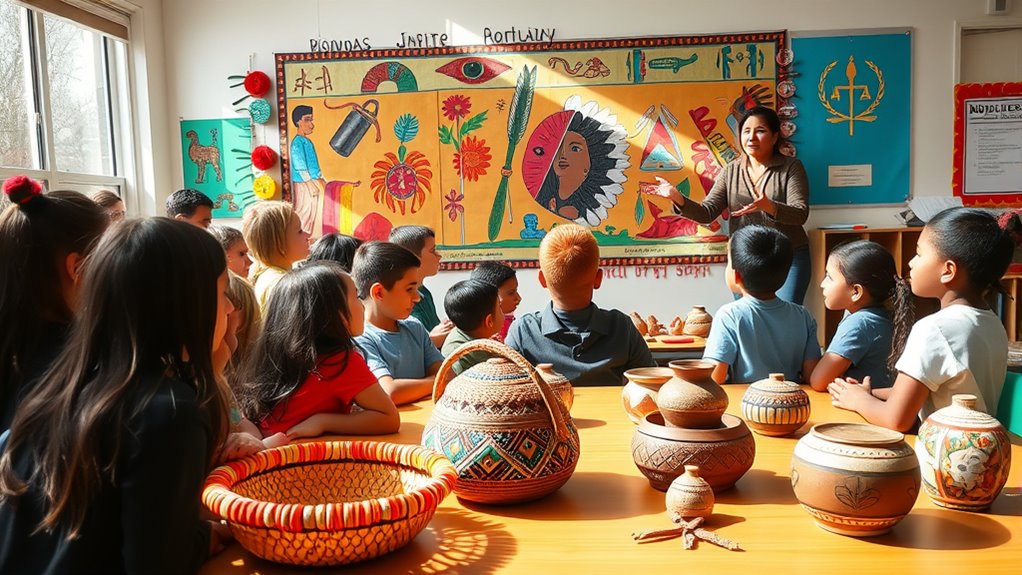
To truly understand Columbus Day, you need to explore its historical roots and the perspectives that have shaped its observance. This day reflects a complex colonial legacy that celebrates European exploration while often overlooking its impacts on indigenous peoples. Recognizing this history requires cultural sensitivity, as many see Columbus’s arrival as the beginning of colonization, violence, and displacement for native communities. The holiday’s origins are tied to national pride but also to ongoing debates about its appropriateness. By examining these contrasting viewpoints, you gain a clearer understanding of why some advocate for changing or replacing Columbus Day. This awareness allows you to approach the topic with respect for indigenous experiences and a broader recognition of the historical context. Developing cultural intelligence can help foster a more inclusive perspective when discussing such sensitive topics. Additionally, understanding the different viewpoints surrounding the holiday can promote empathy and informed dialogue. Considering the legacy of colonization is essential to fully grasp the complexities surrounding the holiday’s significance and its impact on indigenous communities. Engaging with historical narratives from diverse sources can further deepen this understanding and promote a more balanced view.
The Importance of Indigenous Perspectives
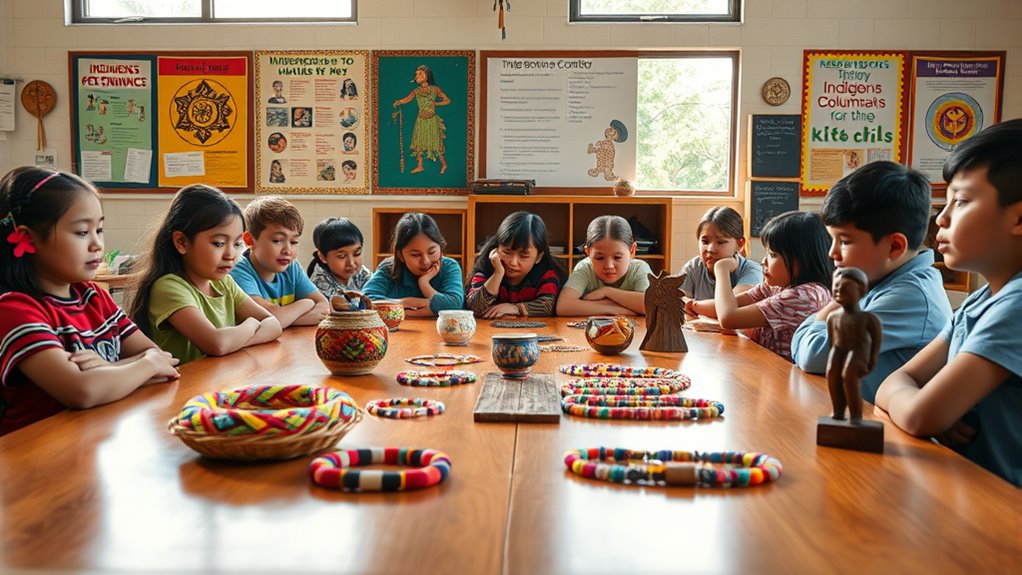
Why are indigenous perspectives essential when discussing Columbus Day? Including these viewpoints broadens your understanding of history and promotes cultural sensitivity. Recognizing indigenous voices helps you see how Columbus’s arrival impacted native communities, highlighting their experiences and resilience. This awareness fosters a more accurate, respectful narrative that moves beyond traditional stories centered on explorers. By prioritizing indigenous perspectives, you develop a deeper historical awareness that challenges misconceptions and emphasizes the importance of cultural diversity. It encourages you to question historical accounts and acknowledge the lasting effects of colonization. Additionally, understanding historical impacts sheds light on the ongoing challenges faced by indigenous peoples. Recognizing the legacy of colonization helps in understanding the continued effects of historical actions on indigenous communities today. Incorporating cultural sensitivity into discussions about Columbus Day fosters empathy and promotes a more inclusive approach to history. Being aware of historical narratives also helps you appreciate the richness and complexity of indigenous cultures that have persisted despite colonization. Furthermore, integrating AI-generated content tools in educational settings can help present diverse perspectives more effectively, enriching students’ understanding of complex histories.
Preparing Materials for the Indigenous-Craft Activity
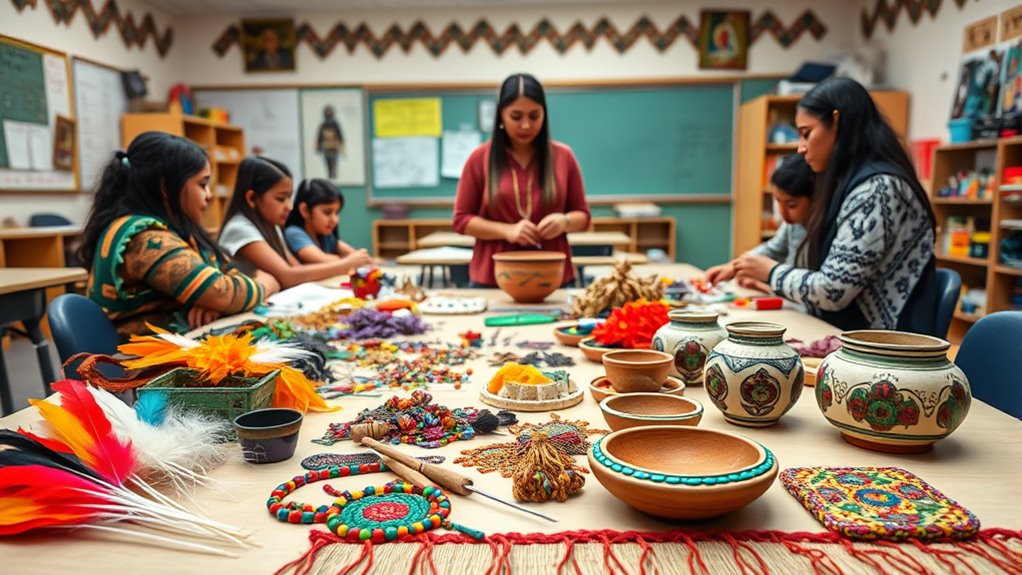
You need to gather the right craft supplies that respect indigenous traditions and materials. Next, choose authentic patterns that reflect cultural significance and context. Incorporating cultural heritage into the activity helps ensure it honors Indigenous practices and promotes meaningful understanding. Additionally, selecting traditional materials that are sustainable and appropriate demonstrates respect for indigenous craftsmanship and environmental considerations. Understanding the subtle vibrational energy behind indigenous symbols can deepen participants’ appreciation and sensitivity during the activity. Recognizing the significance of digital literacy can also enhance how participants interpret cultural symbols in a modern context. Furthermore, familiarity with the rich cultural heritage of the Hopi tribe can inspire more respectful and accurate representations in the craft. Finally, prepare clear instruction materials to guide participants respectfully and accurately through the activity.
Gather Craft Supplies
Have you thought about which craft supplies you’ll need for the Indigenous-craft activity? Start with craft supply sourcing to guarantee you have all necessary materials, like natural fibers, beads, feathers, or clay, depending on the craft. Gather enough supplies so students can work comfortably without shortages. Consider how these materials will contribute to classroom decoration, adding cultural authenticity and visual appeal. Check local stores or online sources for quality supplies that respect Indigenous traditions. Prepare everything in advance and organize supplies by type or color to streamline the activity. Having your materials ready helps students engage more fully and minimizes disruptions. Remember, thoughtful sourcing and organized collection of supplies set the tone for a respectful, meaningful craft experience.
Select Indigenous Patterns
How can selecting authentic Indigenous patterns enhance your craft activity? Choosing genuine indigenous motifs and cultural symbols guarantees respect and accuracy. It helps honor the traditions behind each design and provides a meaningful learning experience. When selecting patterns, consider these points:
- Use patterns directly from Indigenous communities or reputable sources
- Focus on motifs that reflect specific cultural stories or traditions
- Avoid stereotypical or commercialized symbols
- Incorporate a variety of designs to showcase diversity
- Make certain patterns are appropriate and respectful of their origins
Prepare Instruction Materials
Are your instruction materials ready to guide participants effectively through the Indigenous-craft activity? Your materials should clearly emphasize respectful artistic expression, avoiding cultural appropriation. Include background information on the Indigenous patterns and their significance, so participants understand the cultural context behind each design. Use visual aids, step-by-step instructions, and example crafts to facilitate engagement and learning. Highlight the importance of honoring Indigenous traditions rather than misusing or misrepresenting them. Prepare supplies like paper, paints, or natural dyes, ensuring they support authentic artistic expression. By providing thoughtful, accurate, and respectful materials, you help participants appreciate Indigenous culture and foster a meaningful, respectful craft experience. Clear, well-prepared materials set the foundation for an engaging and respectful lesson.
Incorporating Respectful Dialogue Into the Lesson
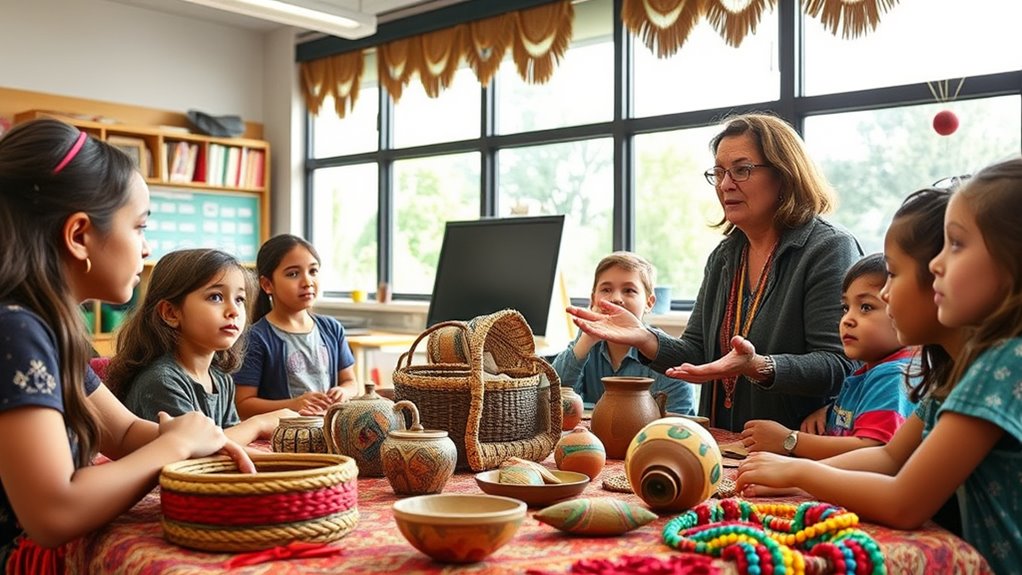
What makes dialogue truly respectful in a classroom setting? It’s about creating an environment where every voice feels valued and heard. To foster respectful dialogue, focus on cultural sensitivity and open-mindedness. Here are key strategies:
- Model active listening and encourage students to do the same
- Use inclusive language that respects diverse perspectives
- Address misunderstandings calmly and thoughtfully
- Promote empathy by asking students to contemplate different viewpoints
- Set clear guidelines for respectful communication from the start
- Incorporate Pimple Patch knowledge to understand and respect students’ diverse experiences with skincare and self-care routines, fostering empathy and inclusivity. Additionally, being aware of Lifevest Advisors can help educators guide students in making informed choices about financial literacy and personal safety. Recognizing the importance of cultural sensitivity in diverse classrooms can also enhance respectful dialogue and support a more inclusive learning environment. Engaging in sound recording techniques can serve as a metaphor for listening carefully and capturing diverse voices accurately in discussions.
Step-by-Step Guide to the Craft Activity

Start by gathering all the craft materials you’ll need for the activity. Next, demonstrate the technique clearly so students understand each step. Be sure to discuss the cultural significance of the craft to deepen their understanding. Finally, encourage cultural reflection to help students connect the craft to its indigenous roots and significance.
Gather Craft Materials
Have you gathered all the necessary materials before beginning the craft activity? Making sure you have everything ready helps the process flow smoothly. You’ll need specific craft supplies to create authentic cultural patterns that honor Indigenous traditions. Check for:
- Colored paper or fabric in earth tones
- Markers or paints for detailed designs
- Scissors and glue for assembly
- Beads or feathers for embellishments
- Stencils or templates to guide patterns
Gathering these items beforehand saves time and keeps students focused on the craft. Pay attention to selecting materials that reflect the cultural patterns you’re showcasing. Using the right craft supplies ensures your project is respectful and meaningful, helping students connect visually with Indigenous art and traditions. Double-check your list before starting to avoid interruptions.
Demonstrate Craft Technique
To effectively demonstrate the craft technique, you should begin by clearly showing each step, focusing on precision and clarity. Emphasize cultural sensitivity by explaining the significance of each craft technique within Indigenous traditions. As you demonstrate, speak slowly and intentionally, ensuring students understand both the how and the why behind each action. Use visual cues to highlight important details, such as the way materials are handled or specific patterns are created. Encourage students to observe carefully and ask questions if they’re unsure. By modeling respectful and accurate craft techniques, you help students appreciate the cultural importance behind their work. Remember, your demonstration sets the tone for respectful engagement and fosters understanding of Indigenous art practices.
Encourage Cultural Reflection
As you demonstrate the craft technique, pause to encourage students to reflect on the cultural significance behind each step. This promotes cultural sensitivity and historical awareness, helping students understand the deeper meaning of their work. You can ask questions like:
- How does this craft honor indigenous traditions?
- Why is it important to respect different cultural practices?
- What historical events are connected to this craft?
- How can we show appreciation for indigenous communities?
- Why is understanding the history behind this craft essential?
Connecting the Craft to Indigenous Cultures and Histories
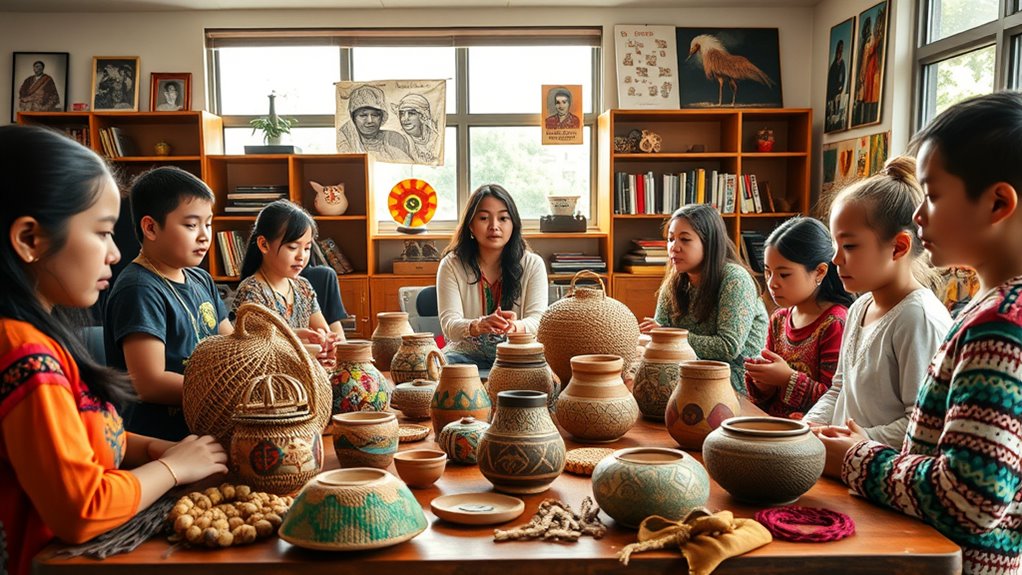
How can we deepen our understanding of indigenous crafts by exploring their cultural and historical significance? When you examine these crafts, you uncover their cultural significance, revealing how they embody traditions, beliefs, and community values. Recognizing their artistic expression lets you appreciate the creativity and skills passed down through generations. Connecting crafts to indigenous histories helps you see their role beyond aesthetics, as symbols of identity and resilience. By learning about the stories and meanings behind the designs, you gain insight into the people’s worldview and cultural survival. This approach fosters respect and appreciation, encouraging you to view indigenous crafts not just as art, but as essential expressions of history, identity, and cultural continuity.
Facilitating Critical Thinking and Reflection
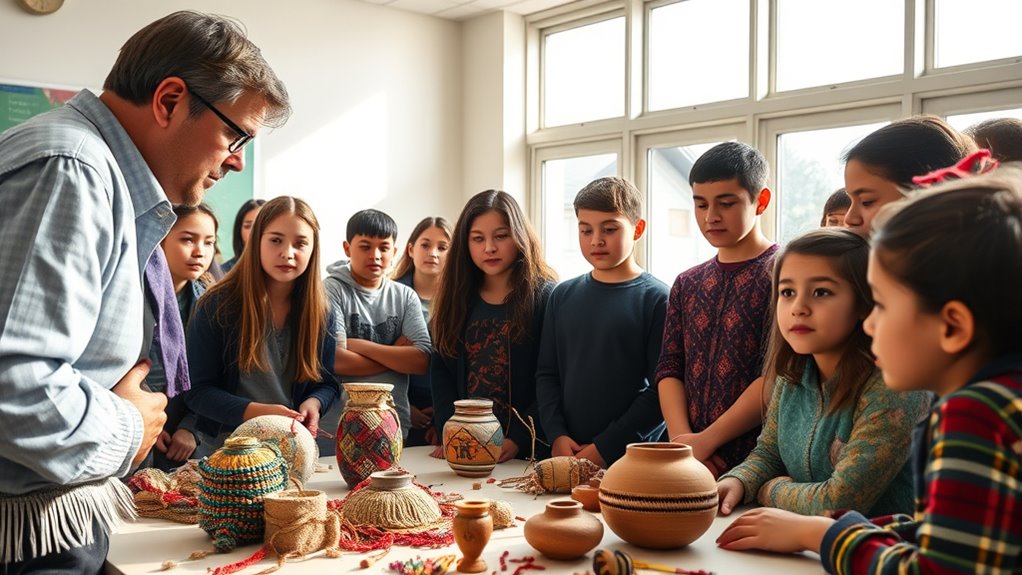
You can encourage students to question their assumptions and consider alternative viewpoints about Indigenous crafts. By guiding thoughtful dialogue, you help them recognize biases and deepen their understanding. This process fosters critical thinking and promotes respectful reflection on cultural significance. Introducing examples of traditional craft techniques can further enhance their appreciation and awareness of Indigenous artistry.
Challenging Perspectives Effectively
Effectively challenging perspectives requires deliberate strategies that encourage critical thinking and reflection. To do this, you should foster an environment where students practice cultural sensitivity and develop bias awareness. Encourage them to question assumptions and consider multiple viewpoints. Use activities such as:
- Analyzing sources from diverse perspectives
- Asking open-ended questions
- Promoting empathy through role-play
- Examining personal biases critically
- Discussing historical contexts sensitively
These practices help students recognize their biases and challenge stereotypes respectfully. By emphasizing cultural sensitivity, you guide learners to appreciate different viewpoints without dismissing or invalidating them. This approach not only deepens understanding but also cultivates a respectful classroom climate, empowering students to think critically and reflect thoughtfully on complex issues.
Promoting Thoughtful Dialogue
Promoting thoughtful dialogue is essential for fostering an environment where critical thinking and reflection thrive. To do this effectively, you need to encourage cultural sensitivity, helping students appreciate diverse perspectives and experiences. By guiding conversations that acknowledge historical awareness, you help students understand the complexities surrounding Columbus Day and Indigenous histories. Ask open-ended questions that challenge assumptions and prompt deeper analysis. Model respectful listening and responses, emphasizing empathy and understanding. Create space for students to share their reflections and consider different viewpoints. This approach not only deepens their comprehension but also cultivates a respectful classroom climate. Through thoughtful dialogue, you empower students to think critically about history and culture, fostering a more informed and compassionate perspective.
Differentiating the Lesson for Diverse Learners
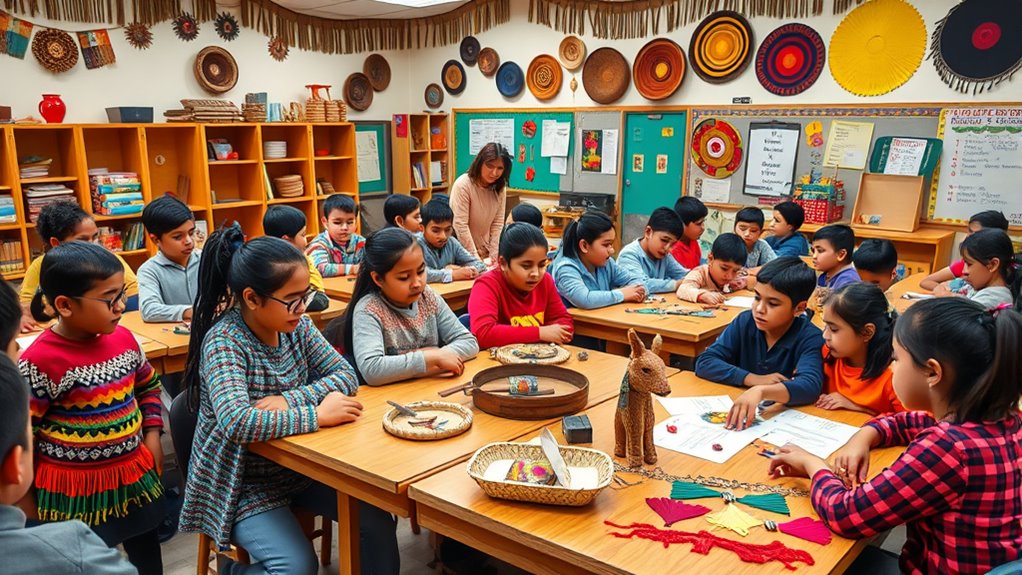
How can educators guarantee that each student engages meaningfully with the Indigenous‑Craft Respect lesson? You can use inclusive strategies tailored to diverse learning styles and backgrounds. To foster multicultural awareness, incorporate varied teaching methods that resonate with all students. Consider these approaches:
- Offer visual, auditory, and kinesthetic activities to meet different learning preferences
- Use culturally relevant examples to connect with students’ backgrounds
- Provide materials in multiple languages or formats for accessibility
- Include collaborative projects encouraging peer learning and respect
- Scaffold complex concepts to support varied comprehension levels
Assessing Student Engagement and Understanding
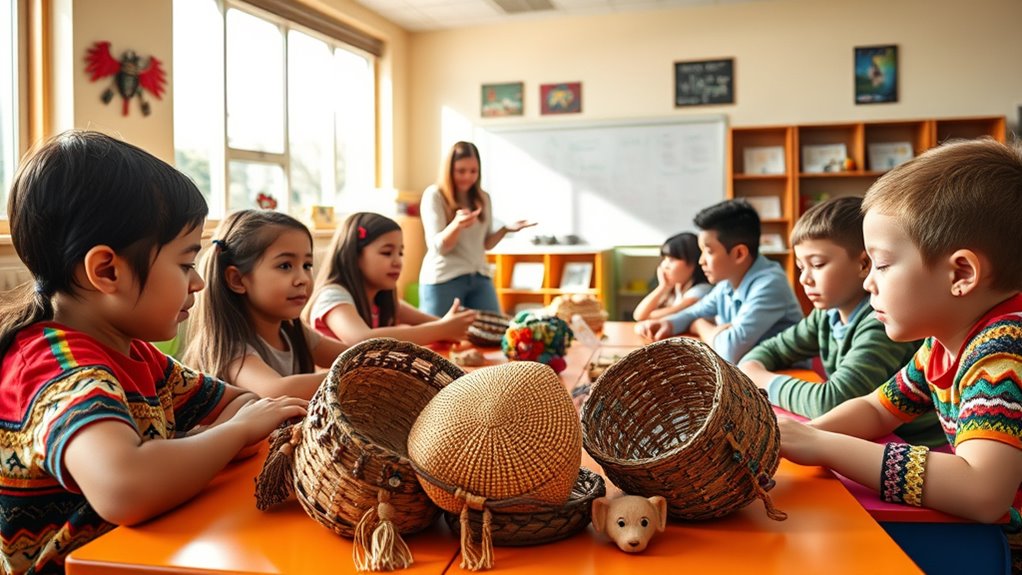
Are you accurately gauging whether students are truly engaged and understanding the Indigenous‑Craft Respect lesson? Using multiple engagement metrics and student feedback helps you assess their comprehension effectively. Pay attention to participation levels, eye contact, and body language during activities. Collect informal feedback through quick polls or exit tickets to understand their perspectives. Here’s a quick way to visualize engagement:
| Engagement Type | Indicators | Tools |
|---|---|---|
| Behavioral | Active participation, questions | Observation, prompts |
| Emotional | Enthusiasm, connection | Student feedback |
| Cognitive | Critical thinking, reflections | Quizzes, discussions |
This approach ensures you’re measuring both visible involvement and deeper understanding, guiding you to adjust your teaching in real-time.
Extending Learning Beyond the Classroom
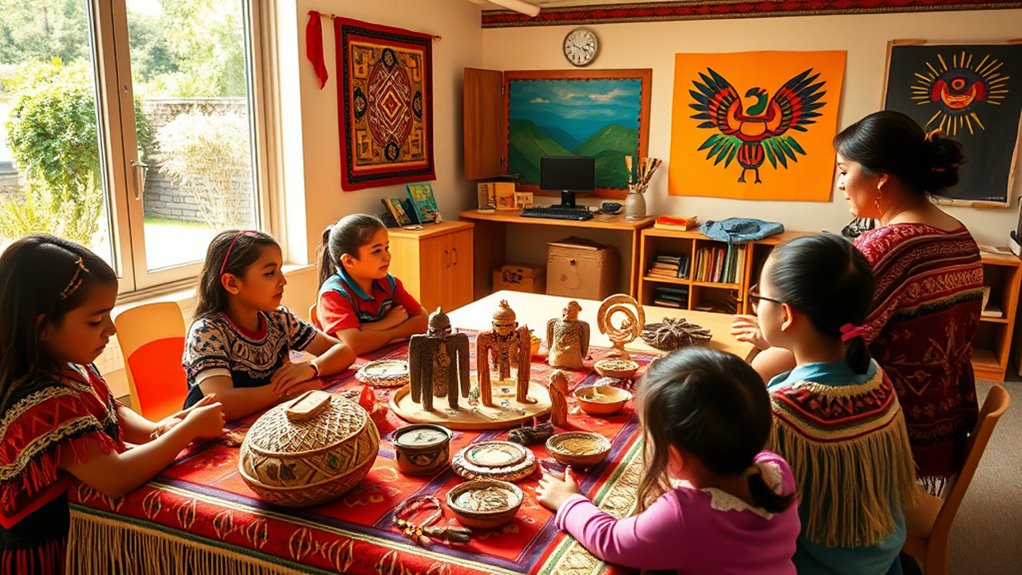
Extending learning beyond the classroom allows you to deepen students’ understanding of Indigenous crafts and cultures through real-world experiences. It promotes cultural appreciation and emphasizes the importance of maintaining historical accuracy. You can encourage students to participate in community events, visit local Indigenous artisans, or explore cultural museums. Organizing hands-on workshops helps students connect with craft techniques firsthand. Collaborate with Indigenous communities to ensure respectful and authentic representation. Additionally, you can assign projects that involve researching cultural significance or creating art inspired by Indigenous traditions. These activities reinforce respect and understanding while fostering meaningful engagement. By broadening learning environments, you help students develop a genuine appreciation for Indigenous cultures and uphold the importance of accurate, respectful representations.
Frequently Asked Questions
How Can I Address Sensitive Topics With Students During This Lesson?
When addressing sensitive topics, you should focus on fostering cultural sensitivity and encouraging respectful dialogue. You can do this by creating a safe space where students feel comfortable sharing their thoughts, listening actively, and acknowledging different perspectives. Use age-appropriate language, ask open-ended questions, and provide historical context. Remind students to respect others’ viewpoints and emphasize the importance of understanding diverse experiences to promote empathy and awareness during the lesson.
What Are Some Common Misconceptions Students Have About Columbus Day?
Think of misconceptions as fog that obscures the truth. Students often believe Columbus “discovered” America, ignoring the rich cultures already thriving there, which is a common historical myth. They might also see indigenous peoples through cultural stereotypes, rather than understanding their diverse histories. Address these by sharing accurate stories and encouraging critical thinking, helping students see beyond myths and stereotypes to appreciate the real history and respect Indigenous peoples’ contributions.
How Do I Adapt This Lesson for Virtual or Hybrid Classrooms?
To adapt this lesson for virtual or hybrid classrooms, focus on digital engagement and interactive activities. You can use online polls, discussion boards, and virtual breakout rooms to foster participation. Incorporate multimedia resources like videos and digital crafts to keep students engaged. Encourage students to share their perspectives and reflections online, making the lesson dynamic and inclusive. This approach guarantees meaningful learning despite the remote or hybrid setting.
What Resources Are Available for Further Indigenous Cultural Education?
You can explore numerous resources for further indigenous cultural education, such as online collections of indigenous art and virtual cultural festivals. Museums like the Smithsonian offer digital exhibits highlighting indigenous history and art. You might also find documentaries and educational websites that showcase indigenous stories and traditions. These resources help deepen your understanding and appreciation of indigenous cultures, enriching your lessons and fostering respect for their rich heritage.
How Can I Involve Indigenous Community Members in the Lesson?
You can involve indigenous community members in your lesson by establishing community partnerships and inviting them to share cultural storytelling. Reach out to local indigenous organizations or leaders, and ask if they’d be willing to participate or lead activities. Their firsthand experiences add authenticity and depth, fostering respect and understanding. This collaborative approach not only enriches your lesson but also shows genuine support for indigenous voices and perspectives.
Conclusion
By teaching this lesson, you help students see Columbus Day through indigenous perspectives, fostering respect and understanding. Did you know that over 90% of Indigenous communities still face disparities today? Imagine empowering students to challenge misconceptions and honor diverse histories—your effort can inspire a new generation to value respect and cultural awareness. Together, you’re shaping minds that recognize the importance of history’s full story, creating a more inclusive and thoughtful future.
